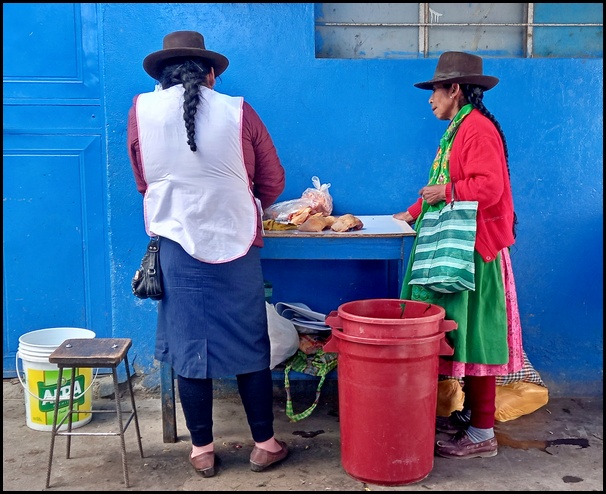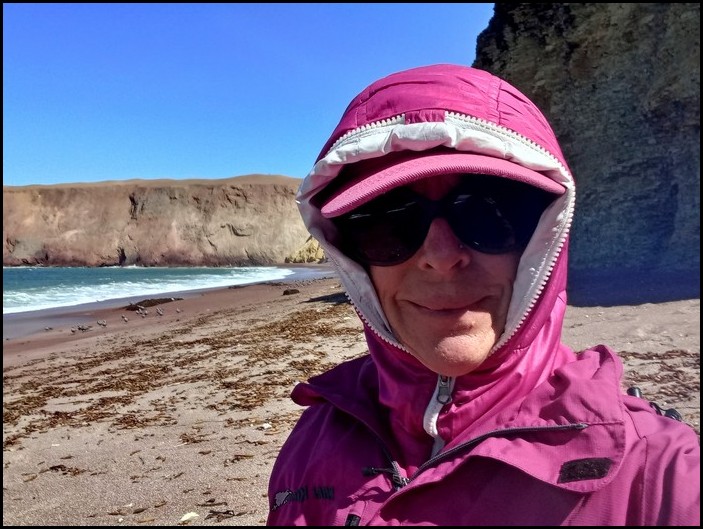
Surviving the Cold Unheated Guesthouses and Hotels of South America
Introduction to South America’s unheated hotels and guesthouses
When I started traveling through the central Andes Mountain region of Ecuador in late February of this year, I soon discovered, much to my great dismay, that Ecuadorians do not use heat inside any of their houses or buildings.
Unfortunately for me, and most other travelers to South America, that also means unheated accommodations. Except for 5-star and 4-star luxury hotels, all travelers’ accommodations come unheated. No matter how cold it gets outside.
And I mean that quite literally. It doesn’t matter how cold the climate is, for example up in the high Andes Mountains, South Americans do not use indoor heating. I’ve slept in unheated guesthouses with outdoor temperatures as low as 30 F / -1 C. The indoor temps are almost the same as outside, albeit – usually – without any wind blowing through.
The warmest night time temperatures I’ve experienced while traveling around South America for more than six months have been about 60-64 F / 15-17 C. Now I don’t know about you, but for me an unheated house at 60-64 F is very uncomfortably chilly. Cold even.
I feel cold just sitting around indoors in that temperature, let alone getting naked to change my clothes, take a shower or climb into bed and sleep.
And, as I just noted, 60-64 F / 15-17 C is the warmest indoor temperatures I’ve had to deal with. Sleeping indoors in those temperatures can be pretty chilly without any heat, but that’s nothing!
Try sleeping in a room that’s in the low-mid 50s F / 10-13 C, like I’ve had to in places like Lima, Paracas and Nazca, Peru. Or how about temps in the 40s F / 5-8 C, like I’ve experienced in Bogota, Colombia and Quinta, Ecuador.
Or how about sleeping without any heat when the outdoor temps are in the 30s F / 0-3 C, like I’ve had to do in Cusco, Peru? What about when it’s literally below freezing, in the 20s F / -5 to -1 C (also in Cusco)?
As insane as this sounds, that’s exactly what South Americans do! And that is exactly what travelers have to do as well. At least budget and midrange travelers.
Any and all hotels, guesthouses, homestays, AirBnBs, hostels, backpackers and any other midrange to budget acommodations are rented out with no heating!
The exceptions are 5-star and 4-star luxury hotels, as I mentioned above. Those hotels, of course, provide heated acommodations and facilities.
Of course the lack of heating is no issue in South American’s many hot and tropical destinations, like the vast Amazon regions of many South American countries and at dozens of coastal cities, beaches & plains. In those places, there may be need for air conditioning, but certainly not for indoor heating.
However, in South America’s vast and sprawling Andes Mountain regions, and even many coastal areas, the climate ranges in day time from warm to chilly to cold, and is definitely cold at night.
The Andes is where a majority of the continent’s most amazing and famous destinations are located. Places like Cuenca and Quito, Ecuador, as well as its many beautiful volcanoes and mountains. Places like Machu Pichu, Cusco the Sacred Valley of the Incas and Lake Titicaca in Peru.
So virtually all travelers to South America are bound to have to deal with the continent’s unheated guesthouse and hotel experience.

My own unheated guesthouse and hotel experiences
When I first started traveling in Ecuador, I was hoping that my unheated room in Cuenca was just particular to that guesthouse, or maybe to Cuenca in general. But as I set out traveling through various towns in the Ecuadorian Andes over two months, I found out that all my rooms came unheated. Turns out nobody uses indoor heating in Ecuador.
So I suffered through cold, unheated guesthouses and hotels for two months in the Ecuadorian Andes. Then I flew to Bogota, Colombia, hoping that the lack of heating was only an Ecuadorian phenomenon.
Alas, I found the same unheated conditions in Colombia. In fact, Bogota was even colder at night than most places I visited in Ecuador!
And then later in Peru I ran into the same exact unheated acommodations as well. Apparently, it’s an entire South American cultural norm. Sigh.
So I’ve had to learn deal with living and sleeping in unheated rooms in cold climates. To help myself stay warm and comfortable, I eventually decided to buy myself two important new travel items: warm slippers and a small electric heater! But more on that later…
First, let’s delve into the how and why of this South American unheated interiors lifestyle…

Why South Americans live without indoor heating
For us Americans and Europeans, who are all accustomed to heated homes, this South American custom of not using indoor heating sounds insane and ridiculous.
So we have to wonder, why? Why suffer through so much cold every night, for months on end?
I’ve asked many locals in each country I’ve visited why they don’t use indoor heating. I’ve also learned a lot about various South American cultures, their histories and lifestyles. And, of course, I’ve been traveling around the continent for more than six months thus far, observing people and daily life.
From what I can gather, there are two main reasons for this custom. The reasons boil down to simple cultural habit and to economics.
Every single local person I’ve asked about this phenomenon has told me exactly the same thing: electricity is very expensive. For that reason, they don’t use indoor heating, they say.
I’ve heard plenty of my hosts complain about the high cost of using refrigerators, microwaves, lights, hot showers and other electrical appliances. I’ve also seen many people routinely turn off their refrigerators every night, including owners of small stores selling refrigerated dairy products and meats. Eek!
So I believe it when they tell me electricity is expensive for them.
But I also think another equally-important reason is pure daily habit and custom. All these people grew up as children with no heat in their houses, nor in their schools, shops or restaurants.
By the time they’re adults, their bodies are acclimatized to unheated conditions. To them it’s perfectly normal. Just like it’s perfectly normal to us to have indoor heating.
As far as I’ve seen, they all seem perfectly comfortable without heating and going through daily life in all sorts of cold temperatures.
In addition, the habit is a long-term historical custom. None of the original South American tribes, including the Incas, Nazcas, Paracas or others, ever heated their homes. So it’s been a lifestyle habit for everyone in South America for centuries. It’s been passed down through the generations all the way to the modern era.

How South Americans live without indoor heating
Instead of heating their homes, South Americans simply wear lots of warm clothes indoors. Sometimes even coats, hats and scarves.
To stay warm sleeping at night, they use several layers of very heavy, thick warm blankets. Many of their bed coverings are more like heavy carpets than blankets. And all those layers do indeed keep you warm at night.
Even I, who tend to get cold easily, often have to peel off one or two blankets at night because I get over-heated. Those blankets are extremely warm.
So even I must admit that keeping the body warm at night really is not a problem. But you do still have to deal with the cold air running through your respiratory system and any uncovered body parts being cold, such as your face and head.
Then there’s getting up into the freezing-cold room at night to use the toilet. And there’s cringing every morning when it’s time to slip out of the nice warm bed to transition into the freezy-cold room in the morning.
So it’s far from ideal, even with plenty of warm blankets.

Other repercussions of living in unheated hotel rooms and guesthouses
As I’ve discovered quite unhappily, there’s a lot more to living in unheated houses than just cold bedroom air. To be sure, the cold air is bad enough. But there’s a lot more to unheated guestrooms than just cold air.
Not only is the indoor air cold, but everything else inside is cold too. The walls are cold. The floors are cold. Windows are cold.
Anything metal, such as door handles, bathroom fixtures, metal railings and keys are cold. Electronics are cold: your phones, laptops and watches. Even fabrics are cold, including sheets, pillow cases and all your clothes.
Let me go into a bit more detail of my own experiences staying in guest houses in South American so you can get a better understanding of daily travel life staying in cold, unheated hotel rooms and houses…
Cold floors
Most floors in the small hotels and guest rooms I’ve stayed in are tiled. Tiles are COLD!
I dont’ know about you, but standing or walking on cold tile floors is like foot torture. Even in thick, heavy-duty winter socks, tiled floors feel cold.
Budget hotels and guest houses in South America almost never place a rug or mat on the bedroom floors. There are just the plain cold tiled floors. And that’s just the bedroom floors.
Not surprisingly, almost all bathroom floors and the floors & walls of showers are also tiled. Those tiles are all cold too.
For some odd reason, budget hotels and guesthouses in South America almost never provide a floor mat/towel for bathroom floors for after showering. Apparently they just expect guests to step out of a nice hot shower onto ice-cold tiled floors.
So imagine stripping down to bare feet in the bathroom and stepping into the shower stall.
I absolutely hate stepping on cold floors. I resolved this South American travel problem by buying myself a pair of nice warm, fluffy winter slippers.
I have to admit that I feel a bit silly and ridiculous carrying around my big bulky fuzzy slippers in my backpack. But, hey, they make all the difference in the world.
I only wish I had bought them sooner. I could have saved myself more than three months of foot torture.
Cold Walls
In general, I’ve found that having cold walls is not much of an issue. I don’t have a habit of leaning on walls or sitting against bare walls.
But there is one place where cold tiled walls can be a real shocker. That’s in the shower.
If the shower is small or even small-ish, it becomes pretty common to bump against the wall with your back or your bum or your leg while you’re maneauvering around, trying to wash every part of your body thoroughly.
I have to say that’s always a sudden shock, that unexpected jolt of freezy-cold against part of your body while the rest of you is steamy hot.

Cold bedsheets
Ok, imagine this…
You’re in your cold bedroom at night, getting ready to climb into bed. You’ve already gone through the torture of stripping off your clothes in the cold room air to put on your pajamas. Now it’s time to pull back the sheets and slide into bed…
As if the cold air wasn’t bad enough…as you slide in between the sheets, you realize that the sheets are COLD too. Oh, and you lay your head down onto a COLD pillowcase as well.
So when you climb into bed at night, you have to use your body heat to warm up the sheets that are wrapped around you
After your body has warmed up the sheets and pillowcase, the bed becomes a lot more comfortable. And the thick piles of heavy blankets will keep you warm through the night (aside from the cold air you’re inhaling and any body parts left to the air, such as face, ears and head).
But if you happen to stretch out one leg or one arm, you’ll quickly be reminded that the rest of the bed sheets and pillows are cold. It’s very strange.
Cold clothes
In the morning, when it’s time to change from your nice warm pajamas into your clothes for the day, it’s quite surprising to discover that all your clothes are really cold. As if you left them outside over-night in the winter.
Eek! Who wants to get naked in cold air, in the first place, and then pull on cold clothes? !
Cold drinking water
Whenever you grab your bottle of water to get hydrated, you take a swig and suddenly, into your mouth and down your throat goes… ice water. Yep, that bottle of water left at room temperature seems to be refrigerated. It’s a quick reminder that the indoor air really is quite cold.
Icy tap water = Icy hands and face
While the showers in South America are usually wonderfully hot, sinks always only have one tap- cold. There is no hot water in bathroom sinks here. Nor kitchen sinks, for that matter.
And, depending on the outdoor temperature, that cold tap water can be mighty icy. If the night time temperature gets down to the 30s or 40s F /0-8 C, then you can be sure that bathroom tap water is going to feel like ice.
In the mornings, be prepared to wash your face in ice water. And when you’re done, you’ll feel like you’ve rubbed your face in a bowl of ice.
You’ll also have matching icy fingers for quite a while until you can warm them up… in a pocket…or wrapped around a hot cup of tea/coffee.
That is really not my ideal way start to the morning, although I keep trying to convince myself that washing my face in ice water feels ‘refreshing’. Yeah, right.
For that matter, any time you wash your hands throughout the day, or wash your dishes after cooking/eating, you’ll end up with icy hands again.
Cold Toilet Seats
Yep, those toilet seats are going to feel pretty icy cold too, on your previously warm bare bottom! That’s especially jolting in the middle of the night.

Keeping myself warm and comfortable traveling without indoor heating
So now you can understand why I eventually decided to help myself out by buying a pair of fluffy warm slippers and a small electric heater. I knew I’d be traveling in cold, and colder, conditions for many, many more months to come. Why suffer?
Yep, although I’ve never had to do so before, in all my 23 years of world travels, and even though I feel a bit silly and ridiculous lugging around these two rather bulky items in my backpack, I’m extremely happy to have these possessions with me. In fact, I only wish I had bought them sooner!
First off, my warm, fluffy slippers have become my ‘go to’ indoor footwear. I wear them not only in my room, but all around my various guesthouses and hotels. They’re a life saver for my feet.
Then, my wonderful heater I pop out in evenings. I try to use it as little as possible, being mindful of the electricity usage. I usually turn it on just one to two hours at night to keep warm while I’m working or watching movies in my room. I turn it off while sleeping.
By morning, of course, my room has reverted to the cold outdoor temperatures, or close to it. I hop out of bed briefly to turn on my heater for a short time, just to take the edge off the cold before I climb out of bed.
I consider my cute little heater a life-saver. I know from plenty of former experience that my body does not do well being cold for extended periods of time. And it certainly makes my life infinitely more comfortable.

Conclusions
If you’re planning to travel around South America, be prepared to face the unheated guesthouses, hotels, hostels and other accommodations on offer around the continent.
If you’re sensitive to cold or don’t enjoy cool, chilly and cold indoor temperatures, you might want to bring along warm slippers or extra-thick socks, a floor towel to place on cold bathroom floors and a lot of warm clothes for indoors.
If you’re planning to travel extensively or really hate cold interiors, you might want to also buy yourself a small, inexpensive electric heater to help stave off the cold in your rooms. I know that for me, my little heater has made my travel life here infinitely more enjoyable.
================================
You might also enjoy:
Introduction to the Spectacular Sacred Valley of PeruSix Delicious Fruits of South America
===============================












 Hi! I'm Lash, an American nomadic world traveler who's been traveling solo since 1998. I’m passionate about traveling the world nomadically and then sharing it all with you. I hope to inspire you to travel the world, to entertain you with tales from the road, and to help you reach your travel dreams. Welcome!
Hi! I'm Lash, an American nomadic world traveler who's been traveling solo since 1998. I’m passionate about traveling the world nomadically and then sharing it all with you. I hope to inspire you to travel the world, to entertain you with tales from the road, and to help you reach your travel dreams. Welcome! 




5 pings
13 Things I Love about South America - LashWorldTour
2022/09/23 at 11:44 pm (UTC 8) Link to this comment
[…] « Surviving the Cold Unheated Guesthouses and Hotels of South America […]